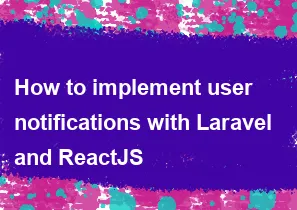How to implement user notifications with Laravel and ReactJS

Implementing user notifications with Laravel and ReactJS involves setting up the backend to handle notifications and creating a frontend interface to display them. Below is a step-by-step guide to achieve this:
Backend (Laravel):
Install Required Packages: Install the Laravel Echo, Pusher, and Laravel Echo Server packages for real-time notifications.
bashcomposer require pusher/pusher-php-server npm install --save laravel-echo pusher-jsConfigure Broadcasting: Update your
config/broadcasting.phpfile to use the Pusher driver.php'default' => env('BROADCAST_DRIVER', 'pusher'),Set the Pusher credentials in your
.envfile:iniBROADCAST_DRIVER=pusher PUSHER_APP_ID=your-app-id PUSHER_APP_KEY=your-app-key PUSHER_APP_SECRET=your-app-secret PUSHER_APP_CLUSTER=your-app-clusterCreate Notification: Create a new notification using Laravel's
make:notificationArtisan command.bashphp artisan make:notification NewNotificationConfigure Notification to Use Broadcast Channel: Open the generated
NewNotification.phpfile and update thetoBroadcastmethod to use thebroadcastAsmethod.phppublic function toBroadcast($notifiable) { return (new BroadcastMessage([ 'message' => $this->message, ]))->broadcastAs('new-notification'); }
Frontend (ReactJS):
Install Required Packages: Install the necessary packages for ReactJS.
bashnpm install react axios pusher-jsSet Up Axios for API Calls: Create a file, e.g.,
api.js, to handle API calls using Axios.javascript// api.js import axios from 'axios'; const api = axios.create({ baseURL: '/api', // Laravel API endpoint }); export default api;Subscribe to Pusher Channel: Create a file, e.g.,
pusher.js, to subscribe to the Pusher channel.javascript// pusher.js import Pusher from 'pusher-js'; const pusher = new Pusher('your-app-key', { cluster: 'your-app-cluster', encrypted: true, }); export default pusher;React Component to Display Notifications: Create a React component to display notifications.
javascript// NotificationComponent.js import React, { useEffect, useState } from 'react'; import api from './api'; import pusher from './pusher'; const NotificationComponent = () => { const [notifications, setNotifications] = useState([]); useEffect(() => { const channel = pusher.subscribe('new-notification'); channel.bind('App\\Events\\NewNotification', (data) => { setNotifications((prevNotifications) => [...prevNotifications, data.message]); }); return () => { channel.unbind(); pusher.unsubscribe('new-notification'); }; }, []); return ( <div> <h2>Notifications</h2> <ul> {notifications.map((notification, index) => ( <li key={index}>{notification}</li> ))} </ul> </div> ); }; export default NotificationComponent;Integrate Component in App: Integrate the
NotificationComponentin your main React application.javascript// App.js import React from 'react'; import NotificationComponent from './NotificationComponent'; const App = () => { return ( <div> <h1>Your React App</h1> <NotificationComponent /> </div> ); }; export default App;
Remember to replace placeholders like 'your-app-key', 'your-app-cluster', etc., with your actual Pusher credentials. Additionally, adjust the Laravel and React code based on your specific application structure and requirements.
-
Popular Post
- How to optimize for Google's About This Result feature for local businesses
- How to implement multi-language support in an Express.js application
- How to handle and optimize for changes in mobile search behavior
- How to handle CORS in a Node.js application
- How to use Vue.js with a UI framework (e.g., Vuetify, Element UI)
- How to configure Laravel Telescope for monitoring and profiling API requests
- How to create a command-line tool using the Commander.js library in Node.js
- How to implement code splitting in a React.js application
- How to use the AWS SDK for Node.js to interact with various AWS services
- How to use the Node.js Stream API for efficient data processing
- How to implement a cookie parser middleware in Node.js
- How to implement WebSockets for real-time communication in React
-
Latest Post
- How to implement a dynamic form with dynamic field styling based on user input in Next.js
- How to create a custom hook for handling user interactions with the browser's device motion in Next.js
- How to create a custom hook for handling user interactions with the browser's battery status in Next.js
- How to implement a dynamic form with dynamic field visibility based on user input in Next.js
- How to implement a dynamic form with real-time collaboration features in Next.js
- How to create a custom hook for handling user interactions with the browser's media devices in Next.js
- How to use the useSWRInfinite hook for paginating data with a custom loading indicator in Next.js
- How to create a custom hook for handling user interactions with the browser's network status in Next.js
- How to create a custom hook for handling user interactions with the browser's location in Next.js
- How to implement a dynamic form with multi-language support in Next.js
- How to create a custom hook for handling user interactions with the browser's ambient light sensor in Next.js
- How to use the useHover hook for creating interactive image zoom effects in Next.js